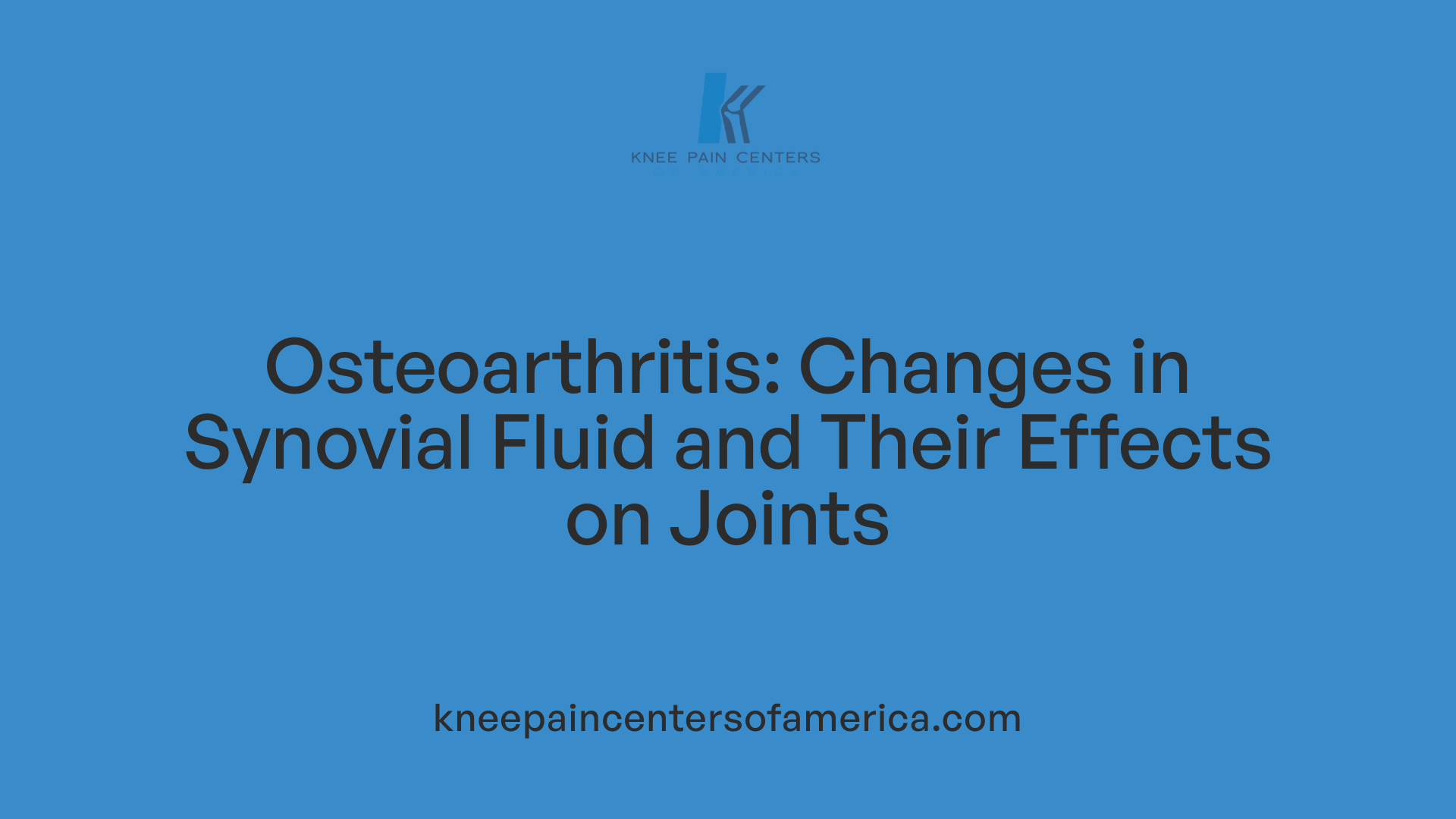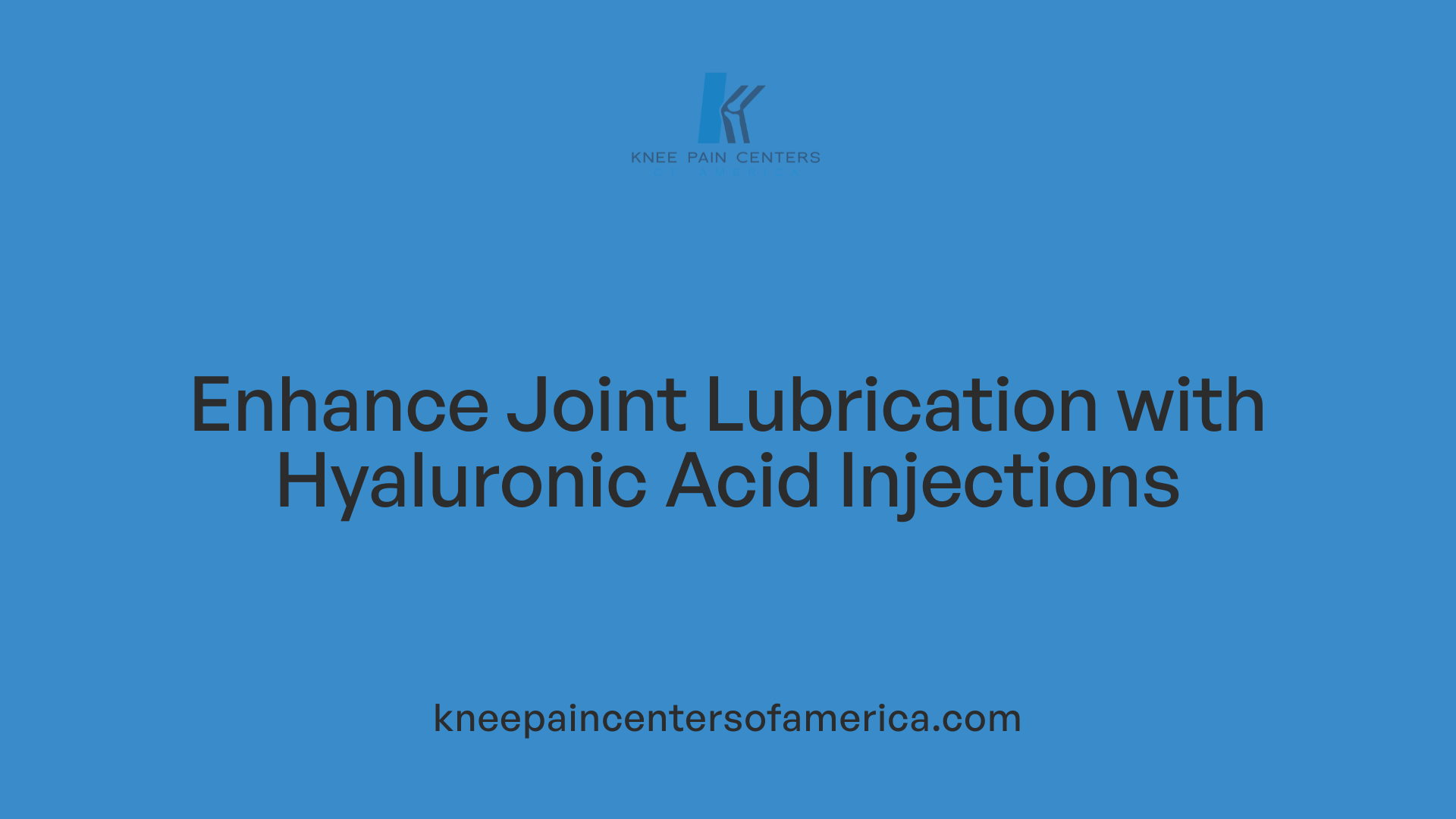Understanding Synovial Fluid and Therapeutic Solutions for Knee Osteoarthritis
Maintaining healthy joints is vital for mobility and quality of life. Central to joint health is synovial fluid, a natural lubricant that ensures smooth articulation and shock absorption within the knee. This article explores the biological role of synovial fluid, how osteoarthritis alters its properties, and how viscosupplementation therapy, particularly hyaluronic acid injections, can help restore joint function, reduce pain, and might slow degenerative processes.
The Biological Function of Synovial Fluid in Knee Joints

What is the role of synovial fluid in maintaining joint health?
Synovial fluid is a vital component of healthy knee joints, acting primarily as a natural lubricant. It ensures that joint surfaces glide smoothly against each other, greatly reducing friction during movement. This smooth operation is essential for pain-free mobility and the overall health of the joint.
Beyond lubrication, synovial fluid serves as a protective shock absorber. It disperses loads and dissipates forces exerted on the joint during activities like walking, running, or jumping. By cushioning the bones, it helps prevent damage caused by sudden or excessive pressure.
Nutrient delivery is another important function. Cartilage, which covers the ends of bones, is avascular, meaning it does not have its own blood supply. Instead, it relies on synovial fluid to supply essential nutrients and oxygen. This sustains the health of cartilage and promotes its repair.
Furthermore, synovial fluid plays a role in removing metabolic waste products generated by joint tissues. Regular circulation of this fluid helps rid the joint space of debris and waste, maintaining a clean environment necessary for joint longevity.
The balance and quality of synovial fluid reflect the joint’s health status. Changes in its composition or volume can indicate conditions like infection, gout, or osteoarthritis. For example, in osteoarthritis, the hyaluronic acid that gives synovial fluid its viscous properties diminishes, impairing lubrication and shock absorption.
In clinical settings, analyzing synovial fluid samples through procedures such as arthrocentesis helps diagnose and monitor joint diseases. Understanding these functions underscores the importance of synovial fluid in keeping your joints moving smoothly and healthily.
Impact of Osteoarthritis on Synovial Fluid and Joint Function

How does osteoarthritis affect synovial fluid and joint function?
Osteoarthritis leads to substantial changes in the composition and quality of synovial fluid, which is essential for healthy joint function. In healthy joints, synovial fluid contains high levels of hyaluronic acid (HA), providing necessary viscosity and elasticity that enable smooth, pain-free movement. However, with osteoarthritis, the concentration and molecular weight of HA decrease. This reduction results in less viscous and elastic synovial fluid, impairing its lubricating and shock-absorbing abilities.
As a consequence, the joints experience increased friction between cartilage surfaces. This elevated mechanical stress accelerates cartilage wear and breakdown. The degenerative process not only worsens pain and stiffness but also diminishes joint mobility. The deterioration of joint surfaces further exacerbates the structural damage, creating a cycle of worsening joint function.
In addition to physical changes, osteoarthritis is associated with heightened inflammatory activity within the joint. Elevated levels of cytokines such as tumor necrosis factor-alpha (TNF-α) and interleukin-1 beta (IL-1β) are found in the synovial fluid. These inflammatory mediators promote the production of enzymes that break down cartilage matrices, intensify inflammation, and contribute to symptoms.
Interventions like viscosupplementation with hyaluronic acid aim to replenish the compromised synovial fluid. By restoring viscosity and reducing inflammation, these treatments seek to slow disease progression and relieve symptoms.
Overall, osteoarthritis alters both the mechanical and biochemical environment of the joint, leading to pain, stiffness, and reduced mobility. Addressing these changes through medical management can help improve joint function and quality of life for affected individuals.
| Aspect | Change Observed | Impact on Joint Function | Supporting Details |
|---|---|---|---|
| Hyaluronic Acid Levels | Decreased concentration and molecular weight | Reduced viscosity and elasticity | Impairs lubrication and shock absorption |
| Synovial Fluid Viscosity and Elasticity | Lower than normal | Increased friction, joint surface wear | Contributes to cartilage degeneration |
| Inflammatory Cytokines | Elevated (e.g., TNF-α, IL-1β) | Promotes inflammation, cartilage breakdown | Further damages joint tissues |
| Cartilage Integrity | Progressive deterioration | Loss of joint cushioning | Leads to pain, stiffness, and joint dysfunction |
| Treatment Effectiveness | Partial restoration with hyaluronic acid injections | Improved lubrication and reduced inflammation | Can delay surgery and improve mobility |
Viscosupplementation: Restoring Joint Lubrication and Alleviating Pain

What is viscosupplementation and how does it treat knee osteoarthritis?
Viscosupplementation is a medical procedure designed to provide relief for individuals suffering from knee osteoarthritis. It involves injecting hyaluronic acid (HA), a natural component of synovial fluid, directly into the joint space. This treatment aims to restore the viscosity and elastic properties of the synovial fluid, which are often diminished in osteoarthritis.
By improving the lubrication and shock-absorbing qualities of the joint, viscosupplementation reduces pain and inflammation. The injected hyaluronic acid helps cushion the knee, making movements smoother and less painful. It also supports the health of cartilage and may delay the need for surgical interventions like knee replacement.
Injection procedure and typical timeline
The procedure is performed in an outpatient setting, usually during a regular office visit. The area around the knee is thoroughly cleaned, and a local anesthetic may be applied to minimize discomfort. Sometimes, imaging techniques like ultrasound or X-ray guidance are used to ensure accurate needle placement.
Typically, patients receive between one to five injections spaced one week apart. These injections involve delivering a gel-like hyaluronic acid formulation directly into the joint. Post-injection, patients are advised to avoid strenuous activities for about 48 hours and can usually resume normal activities shortly afterward.
Many patients notice symptom improvement within 8 to 12 weeks. The benefits of viscosupplementation can last from several months up to a year or more, and repeat treatments may be considered if symptoms return.
Mechanism of action and components involved
Hyaluronic acid is naturally produced by the synovial membrane within joints, providing viscosity and elastic support to the synovial fluid. In osteoarthritis, the quantity and molecular weight of HA decrease, leading to less effective lubrication and shock absorption.
Viscosupplementation involves injecting exogenous hyaluronic acid that can be derived from animal sources or bio-fermentation. The therapeutic hyaluronic acid mimics natural synovial fluid but with enhanced viscosity, helping to restore normal joint mechanics.
The effects of hyaluronic acid are influenced by its molecular weight; high-molecular-weight formulations tend to provide better lubrication. The treatment aims to improve the biochemical environment of the joint shape by reducing cytokine production, decreasing inflammatory mediators, and promoting cartilage health.
Clinical benefits and evidence
Research shows that viscosupplementation offers significant symptomatic relief for many patients with knee osteoarthritis. Clinical trials, including randomized controlled studies, have demonstrated reductions in pain and improvements in joint mobility.
Patients with mild to moderate osteoarthritis tend to benefit the most. The treatment can also delay the progression of cartilage degeneration and postpone the need for surgery.
Side effects are generally mild and include temporary swelling, warmth, or pain at the injection site. Serious adverse reactions are rare. Overall, hyaluronic acid injections are considered safe, effective, and a valuable addition to multimodal osteoarthritis management.
| Aspect | Details | Additional Notes |
|---|---|---|
| Typical Number of Injections | 1-5 | Usually spaced one week apart |
| Duration of Effect | Several months to over a year | May require repeat treatments |
| Main Components | Hyaluronic acid | Derived from avian sources or bacterial fermentation |
| Benefits | Pain reduction, improved mobility, delayed surgery | Especially effective in early stages of osteoarthritis |
| Side Effects | Mild, including pain, swelling, redness | Rare allergic reactions |
| Objective | Restore synovial fluid viscosity | Support cartilage, reduce inflammation |
How Hyaluronic Acid Injections Improve Joint Function

How do hyaluronic acid injections improve joint lubrication and function?
Hyaluronic acid injections mainly work by replenishing and enhancing the natural hyaluronic acid present in the synovial fluid of joints. In osteoarthritis, this fluid becomes thinner and less viscous, leading to increased friction and less shock absorption. By injecting hyaluronic acid directly into the joint, the treatment boosts the viscosity and elasticity of the synovial fluid.
This improved fluid provides better lubrication, allowing bones to glide more smoothly over each other during movement. It also acts as a shock absorber, dispersing the impacts that occur during activities like walking or climbing stairs.
In addition to mechanical benefits, hyaluronic acid can reduce inflammation within the joint. It interacts with cell surface receptors and modulates production of cytokines and enzymes linked to joint degeneration. This combination of restoring lubrication and dampening inflammatory processes helps alleviate pain, reduce stiffness, and improve overall joint function.
Effects from these injections typically last several months, and repeated treatments can help maintain joint mobility. Overall, hyaluronic acid injections support the joint’s natural mechanisms, promoting smoother movement and alleviating symptoms associated with osteoarthritis.
Improving Knee Joint Health Through Scientific and Therapeutic Advances
In sum, the health and functionality of the knee joint heavily depend on the quality and quantity of synovial fluid. As osteoarthritis diminishes this natural lubricant and protector, treatments like viscosupplementation with hyaluronic acid injections emerge as valuable options. By restoring viscosity, reducing inflammation, and supporting cartilage integrity, these injections can effectively alleviate pain and improve mobility, especially when applied in early stages of osteoarthritis. Ongoing research continues to refine these therapies and explore their potential in delaying joint degeneration, emphasizing their role within a comprehensive approach to joint health management.
References
- Viscosupplementation Treatment for Knee Arthritis - OrthoInfo
- VISCOSUPPLEMENTATION - PMC
- Viscosupplementation Treatment for Arthritis | Johns Hopkins Medicine
- Viscosupplementation for Osteoarthritis of the Knee: A Key Opinion ...
- Viscosupplementation: What You Need to Know
- The Benefits of Viscosupplementation for Osteoarthritis
- Your Guide to Relieve Knee Pain with Viscosupplementation ...





